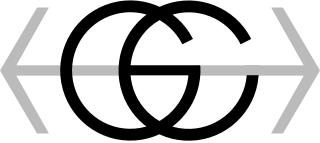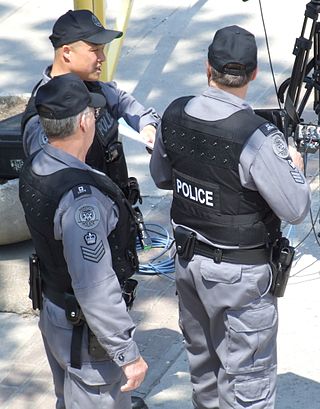
Parliament Hill, colloquially known as The Hill, is an area of Crown land on the southern bank of the Ottawa River that houses the Parliament of Canada in downtown Ottawa, Ontario. It accommodates a suite of Gothic revival buildings whose architectural elements were chosen to evoke the history of parliamentary democracy. Parliament Hill attracts approximately three million visitors each year. The Parliamentary Protective Service is responsible for law enforcement on Parliament Hill and in the parliamentary precinct, while the National Capital Commission is responsible for maintaining the nine-hectare (22-acre) area of the grounds.

The Royal Alexandra Interprovincial Bridge, also known as the Alexandra Bridge or Interprovincial Bridge, is a steel truss cantilever bridge spanning the Ottawa River between Ottawa, Ontario and Gatineau, Quebec. In addition to carrying vehicle traffic, a shared use pathway on the bridge for pedestrians and cyclists is maintained by the National Capital Commission.

The Tomb of the Unknown Soldier is a tomb situated before the National War Memorial in Confederation Square, Ottawa, Ontario. The tomb is dedicated to Canadian service members, and holds the remains of an unidentified Canadian soldier who died in France during the First World War; selected from a Commonwealth War Grave near Vimy, in the vicinity where the Battle of Vimy Ridge took place. A similar memorial was installed in June of 2024 at the National War Memorial in St. John's, Newfoundland to contain the unidentified Great War remains of a soldier of the Royal Newfoundland Regiment.
On 12 June 2000, a bus was hijacked at gun-point by Sandro Barbosa do Nascimento in Jardim Botânico, Rio de Janeiro, Rio de Janeiro, Brazil and hostages were held for 5 hours.

Greyhound Canada Transportation ULC was an intercity coach service that began as a local British Columbia bus line in the early 1920s, expanded across most of Canada, and became a subsidiary of the American Greyhound Lines in 1940.

Gray Coach was a Canadian inter-city bus line based in Toronto, Ontario, from 1927 to 1992. It was founded and initially owned by the Toronto Transportation Commission, until sold to Stagecoach in 1990. In 1992 the business was sold to Greyhound Canada and the brand was retired.

Henry James Friel was mayor of Bytown in 1854 and then of Ottawa in 1863 and 1868–1869.

The Emergency Task Force (ETF) is the police tactical unit of the Toronto Police Service. Created in 1965, it is mandated to deal with high-risk situations like hostage-taking, emotionally disturbed persons, high-risk arrests, warrant service, protection details, and crowd control. The Emergency Task Force is also responsible for responding to any terrorist incidents that occur throughout the City of Toronto.

Ottawa station, or Ottawa Train Station, is the main inter-city train station in Ottawa, Ontario, Canada. It is located 4 kilometres (2.5 mi) east of downtown Ottawa, adjacent to Tremblay O-Train station in the neighbourhood of Eastway Gardens. The station is operated by Via Rail and serves inter-city trains connecting to Toronto, Kingston, Montreal and Quebec City on Via Rail's Corridor Route. It also serves as an intercity bus stop for several bus operators.

Montreal Road, also known as Ottawa Road #34, is a major east-west Ottawa road that links Lowertown to Vanier and the farther eastern neighbourhoods of Ottawa. Until downloading in 1998, it was part of the provincially managed Highway 17B.

Ottawa Central Station was the main inter-city bus station in Ottawa, Ontario, Canada. It was located 1.5 km south of downtown Ottawa in the Centretown neighbourhood and served buses from Greyhound Canada, Ontario Northland and Autobus Gatineau. It closed on June 1, 2021, and the land it sat on is now owned by Brigil, a real estate developer, who plans to build a multi-use space for housing, dining, retail, and other businesses.
Bus companies in Ontario range in scale from small family-run businesses to subsidiaries of large international transportation groups. Many operate yellow school buses for student transportation on behalf of local school boards, while others concentrate on luxury coach charters and tours. Some municipalities use these private companies to run their public transit systems.

CanJet Flight 918 was a flight that was scheduled to take off from Sangster International Airport (MBJ), Montego Bay, Jamaica, on 19 April 2009, bound for Halifax Stanfield International Airport (YHZ), Halifax, Canada, but was instead seized before takeoff for hours by an armed, lone hijacker. This was likely the fourth hijacking on Jamaican soil, and the second time a Canadian airliner had been hijacked.

The 1985 Turkish embassy attack in Ottawa was the storming and attack that took place on 12 March 1985 by agents of the Armenian Revolutionary Army against the Turkish embassy in Ottawa, Canada.
Intimidation of Parliament is a criminal law in Canada that makes it a crime to violently intimidate the Parliament of Canada and the provincial legislatures. The maximum sentence is fourteen years. It reads:
Intimidating Parliament or legislature
51. Every one who does an act of violence in order to intimidate Parliament or the legislature of a province is guilty of an indictable offence and liable to imprisonment for a term not exceeding fourteen years.
The death and state funeral of Pierre Trudeau took place in 2000. Pierre Trudeau was the 15th prime minister of Canada, serving from 1968 to 1984, with a brief interruption in 1979–1980. Trudeau died on September 28, 2000. His casket lay in state on Parliament Hill from September 30 to October 1 and the following day at Montreal City Hall. On October 3, a state funeral was held at Notre-Dame Basilica in Montreal.

John Ciaccia was a Canadian politician who was provincial cabinet minister from Montreal, Quebec. Ciaccia served as a member of the National Assembly of Quebec from 1973 to 1998, representing the Mount Royal riding for the Quebec Liberal Party. He occupied various posts in the cabinets of Liberal premiers Robert Bourassa, and Daniel Johnson Jr., such as minister of Energy and Natural Resources, International Affairs, Native Affairs, and Immigration and Cultural Communities. At his resignation, Ciaccia was the longest-serving member of the Assembly. Ciaccia gained international attention for his efforts in negotiating the end of the Oka Crisis alongside his federal counterpart, Tom Siddon, in 1990. Former Quebec Premier Jean Charest described Ciaccia's political career as having "revolutionized relations with the native people and cultural communities of Quebec by always favouring an approach marked by respect."

The 2014 shootings at Parliament Hill occurred on 22 October 2014, at Parliament Hill in Ottawa. Corporal Nathan Cirillo, a Canadian soldier and reservist on ceremonial sentry duty, was fatally shot at the National War Memorial, followed by an attack on the nearby Centre Block parliament building, where members of the Parliament of Canada were attending caucuses. The attack ended with a shootout when the perpetrator, 32-year old Michael Zehaf-Bibeau, ran inside the parliament buildings and was shot 31 times by six RCMP officers and died on scene. Following the shootings, the downtown core of Ottawa was placed on lockdown and majority of schools in Ottawa were on lockdown while police searched for any potential additional threats.
Don Goodwin was a Canadian announcer and media executive. He spent a 31-year career with the Canadian Broadcasting Corporation (CBC), during which time he was the head of television entertainment and the CBC Sports division; led the network's coverage of the 1976 Summer Olympics in Montreal; and served as the director of the Ontario region. He was most famous for a 23-day stint in 1989, when he hosted the CBC's national and Toronto-area evening newscasts during a strike that took The National off the air, which turned him into a household name and face overnight. Goodwin retired months after the strike but continued as a tennis and squash announcer and was the public address announcer for the 1996 Summer Olympics opening ceremony.













